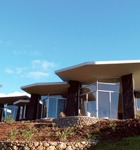
The unique shape of the Hi'Ilani EcoHouse is seen here in the double-residence's floor plan. The large, outdoor entertainment area is also visible.
The Scene
Studio RMA’s Hi’ilani EcoHouse is built on the Hamakua Coast of “the big island” of Hawaii, known for its lush foliage, waterfalls, and ocean views. It sits on a slope near the Wapio Valley and is five miles from the main roads and the nearest small village. Built on a 12-acre farm, the dual-family home is shared by two older couples who are lifelong friends, so the bedroom areas are separate and private while the common areas, including the grand room, kitchen, and dining areas, are shared. But though its occupants share the space, Studio RMA designed the structure itself to stand alone—a self-sufficient, carbon-neutral paradise isolated in the tropics.
The Setup
Because the home was built so far from principal thoroughfares, the materials and personnel needed to build it had to be flown in, and Studio RMA had to find ways to offset the fuel emissions. Additionally, there was a moratorium on tapping into the area’s public water supply, so the residence needed to be completely self-sufficient. Traditional paints could not be used inside the home because of the humidity levels on the island, and there weren’t even enough scaffolds in the area to fulfill Studio RMA’s construction needs, so the firm had to build its own scaffolding in a manner that wouldn’t be wasteful.

The unique geometry and scale of the Hi'ilani EcoHouse are apparent in this construction image. The massive walls are structural concrete insulated panels from Tridipanel.
The Strategy
The resulting Hi’ilani EcoHouse is a 4,000-square-foot home aiming for LEED Platinum certification, and its construction was completely carbon-neutral. Even so, it includes a media center, a recording studio, a spa, a nursing facility, and seating outdoors for 150 people. The property is entirely self-sufficient and pulls no electricity or water from the public supply, and by housing two couples and having them share resources and land, the home reduces each of their ecological footprints. The idea for the home came from one of the couples, a pair connected to the Pachamama Alliance, a San Francisco-based organization that works to help the indigenous people of the Amazon save their rainforests and then spreads what it has learned from its work to other industrialized nations.

Studio RMA offset the carbon output generated by air transportation, shipping, and equipment use during construction by converting three acres of Hawaiian grassland back into tropical forestland. Photo: Robert Mechielsen.
Hi’ilani EcoHouse’s exterior and interior walls are made of structural concrete insulated panels (SCIPs) from Tridipanel of California, and they are resistant to rot, decay, and damage from hurricanes and earthquakes. The home, which will last “centuries as opposed to decades,” was built using 120-degree angles to fit in more appropriately with nature, says Dutch architect Robert Mechielsen, founder and principal of Studio RMA.
The kitchen cabinets were made out of palm wood, and native woods such as mango and koa were used for countertops and other cabinetry. The flooring is made out of bamboo and cork, and wood used for forming and scaffolding was recycled into furniture such as cabinet bases and daybeds for guests. Instead of paint, soy-based colorants and glazes, which were added to the interior plaster, hold or repel humidity as needed, eliminating the risk of condensation and mold. The home’s electricity and hot water are supplied by photovoltaic panels, solar pumps, and a 12-volt DC system, and the water supply comes from a water-catchment system with high-technology filters.
BY THE NUMBERS
3
The number of acres of grassland converted to forestland to offset the carbon output of the Hi’ilani EcoHouse’s construction
30
The number of years it will take for the home to reach true carbon neutrality
150
The number of guests the owners can manageably host for social gatherings
Shaped like a bowl, the space is large enough to use as an entertainment center and seats 150 people. The roof is designed like an airplane wing “because it’s easier to catch the rain, and there is no need for gutters,” Mechielsen says. The wing shape also drives the trade winds toward a louvered set of windows, part of the building’s innovative eco-cooling system: an outdoor weather sensor and a small indoor motor automatically change the windows’ position to generate the flow of air and maintain a moderate temperature.
Looking to cover all of its bases, Studio RMA managed to offset the carbon output generated by air transportation, shipping, and equipment use during construction by converting three acres of Hawaiian grassland back into natural tropical forestland. “[The forest] will take in two and a half tons more carbon dioxide per year than grassland,” Mechielsen says. “[It] will make the entire construction process carbon neutral in about 30 years.”
This truly unique residence will hopefully not be one-of-a-kind for long. Mechielsen launched Studio RMA in 1988, an extension of his Van Holland Design studio in Amsterdam, Netherlands, specifically to design luxury homes with carbon-neutral footprints. Headquartered in Topanga, California, with an office in Hawaii, the firm has three full-time employees and specializes in advanced 3-D computer models that integrate technology, renewable-energy sourcing, and aesthetics. Given the incredible results of this marriage, it’s safe to say the world is ready for more of what Studio RMA is doing.

